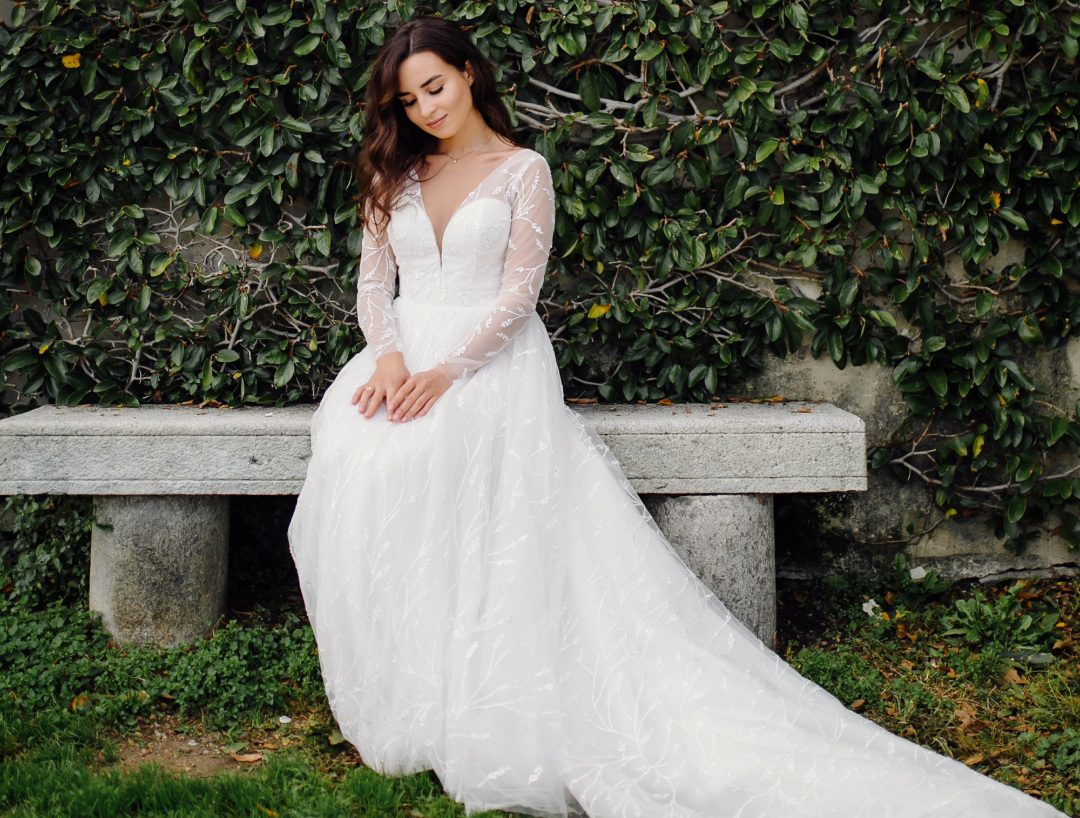While every bride worries about spills, fast-acting stains pose the greatest risk to your dress. A drop of wine or a smudge of lipstick can be far more damaging than a little dirt at the hemline. And by the time you notice, that “small spot” could already be a permanent problem.
Protecting your wedding dress starts with understanding which stains are the most aggressive. These specific kinds of stains can oxidize, discolor, or even weaken fine fabrics like silk or lace.
Let’s take a closer look at those that do the most harm, the fastest.
Celebrations often come with champagne toasts and cocktails, but those spills leave more than a sticky mess. Sugary drinks harden as they dry, locking into silk or lace. Over time, the clear liquid that looked harmless at your reception turns yellow or brown in storage.
| Cause | Effect on Fabric |
|---|---|
| Sugar content | Stiffens lace, tulle, and silk |
| Alcohol + sugar | Turns yellow in storage |
| Residue | Attracts bacteria and mildew |
| Timeframe | What Happens |
|---|---|
| Within hours | Sugar bonds with fibers |
| By the next day | Stain becomes stubborn |
| After weeks | Yellowing and odor appear |
| Common Mistake | Risk |
|---|---|
| Blotting with rough tissue paper | Pushes sugar deeper |
| Soaking dress in the bathtub | Spreads residue |
| Using bleach/detergent | Weakens silk and lace |
Only a wedding dress cleaning specialist can safely dissolve sugar and alcohol without harming delicate fibers. Quick treatment prevents stains from hardening and ensures the dress is preserved for years.
In every wedding celebration, brides will most likely sweat, especially with all the dancing and hugging loved ones. The problem is sweat and oils soak into seams and bodices, leaving invisible marks that later turn yellow. They also bring stubborn odors no closet or tissue paper can mask.
| Factor | Effect |
|---|---|
| Salts + oils | Stiffen silk and polyester |
| Deep penetration | Weakens fibers |
| Long-term yellowing | Spreads in storage |
| Stage | What Happens |
|---|---|
| After ceremony | Looks invisible |
| Weeks later | Yellowing appears |
| Months later | Odor and mildew set in |
| Mistake | Risk |
|---|---|
| Spraying perfume to cover the odor | Mixes chemicals and stains |
| Washing in a machine | Detergents can’t dissolve oils |
| Storing without cleaning | Moisture breeds mildew |
Professional wedding dress cleaning uses solutions that break down body oils without damaging fabrics. This prevents yellowing and odor, especially in humid climates like Texas. Even if sweat isn’t visible, it’s always worth a professional inspection before storage.
Hugs, touch-ups, and photos almost guarantee makeup transfers on veils or bodices. Foundation, lipstick, and mascara are all oil-based, which means they sink into fabric fast. These stains are highly visible on white dresses and grow harder to remove as time passes.
| Type of Makeup | Damage |
|---|---|
| Foundation | Clings to silk/polyester |
| Lipstick | Pigments leave dark marks |
| Mascara | Flakes crumble into lace |
| Timeframe | Effect |
|---|---|
| Immediate | Transfers instantly |
| Minutes later | Begins setting |
| End of ceremony | Already resistant to cleaning |
| Mistake | Risk |
|---|---|
| Rubbing with paper towels | Spreads oils |
| Using water | Makes pigments bleed |
| Covering with powders | Deepens stains |
A wedding dress cleaning specialist uses targeted solvents that safely remove oils and pigments. They protect embroidery, lace, and beadwork while lifting stains.
Deodorant marks may seem minor, but chalky streaks and aluminum buildup create lasting issues. These residues react chemically with sweat and fabric, leaving yellow stains and weakening delicate fibers.
| Cause | Effect |
|---|---|
| Aluminum salts | Leave chalky buildup |
| Fabric reaction | Weakens lace and silk |
| Build-up | Attracts dirt |
| Timeline | Result |
|---|---|
| Within hours | Streaks appear |
| By the end of the wedding | Stain visible |
| Long-term | Yellowing deepens |
| Mistake | Risk |
|---|---|
| Scrubbing streaks | Pushes deeper |
| Using vinegar/harsh cleaners | Damages fabric |
| Sunlight exposure | Darkens yellowing |
Specialized cleaning solutions safely dissolve aluminum salts, preventing permanent damage. Brides who notice streaks should schedule professional wedding dress cleaning right away.
Wedding receptions mean delicious food, but greasy bites and frosting leave oil spots that don’t disappear. These stains settle deep into fibers, leaving shiny marks that resist normal cleaning. Once the heat sets in, grease becomes nearly impossible to remove.
Here’s how food stains work against delicate dresses.
| Cause | Effect |
|---|---|
| Oils | Leave shiny, dark patches |
| Frosting | Combines grease + sugar |
| Heat | Deepens stains |
| Timeline | Effect |
|---|---|
| Immediate | Oil absorbs into fibers |
| Reception’s end | Stains embedded |
| Days later | Permanent discoloration |
| Mistake | Risk |
|---|---|
| Baby powder/flour | Cakes into fabric |
| Scrubbing detergent | Spreads grease |
| Using heat | Locks in stain |
Professional wedding dress cleaning includes degreasing solutions that lift oils without tearing fibers. A wedding dress cleaning specialist can handle these stains quickly and effectively.
Few stains are as dreaded as red wine. Dark drinks like cola and coffee are equally damaging because they contain tannins, dyes, and sugars that cling immediately to fabric. On a white dress, even a splash is painfully visible.
| Cause | Effect |
|---|---|
| Tannins | Bond instantly to fibers |
| Dark pigments | Penetrate lace/silk |
| Sugar | Oxidizes to yellowing |
| Timeline | What Happens |
|---|---|
| Instant | Bonds with fabric |
| Hours later | Darkens |
| Days later | Nearly permanent |
| Mistake | Risk |
|---|---|
| Club soda | Spreads pigments |
| Table salt | Scratches lace |
| Bleach | Ruins fibers |
Professional stain removers target tannins and dyes without harming fabric. Cleaning wedding dress fabrics after red wine exposure should always be left to an expert.
Red wine spreads fast but the dress can be saved if treated quickly by professionals.
Spray tans are popular, but they pose a big risk for dresses. The active ingredient (DHA) oxidizes, leaving brown or orange streaks that deepen over time. On white fabric, these stains stand out immediately and worsen if untreated.
| Cause | Effect |
|---|---|
| DHA chemical | Oxidizes into darker stains |
| Transfer | Creates brown streaks |
| Fabric type | Clings tightly to polyester/tulle |
| Timeline | What Happens |
|---|---|
| Immediate | Transfers on contact |
| Hours later | Chemical reaction begins |
| Days later | Stains deepen |
| Mistake | Risk |
|---|---|
| Wiping with paper towels | Smears stain |
| Using sprays/detergents | Spreads color |
| Trying bleach | Permanently damages the dress |
A wedding dress cleaning specialist can neutralize tanning chemicals safely. Acting quickly ensures the stain doesn’t bond permanently with the fibers.

The most dangerous stains are often unseen. By turning to professional help, your dress still has a huge chance at being beautifully restored, even if it's been months since your big day.
At McLendon Cleaners, we specialize in protecting delicate fabrics, intricate lace, and detailed embroidery from stains that can cause permanent damage. With over 75 years of trusted experience, we care for every dress inhouse. This means, your dress never leaves the hands of our experienced specialists who understand the craftsmanship and emotional value behind it.
Call McLendon Cleaners today to book your professional Wedding Dress Cleaning and Preservation Service. Let us help preserve the beauty, story, and legacy of your wedding dress.
Reach out to us:
Preserve your memories. Protect your dress. Trust McLendon Cleaners with the dress of your life.


✅ Up to 5 clothing pieces
⏰ Includes Next Day Service
Rewards expire at the end of the month!
Exclusions apply. Offer valid on everyday wear only.